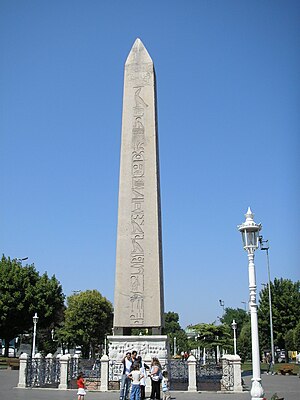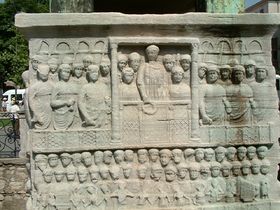Obelisk of Theodosius Contents History Description Notes Bibliography Further reading External links Navigation menuAge of spirituality : late antique and early Christian art, third to seventh centuryOver 60 picturesObelisks of the World41°00′21.24″N 28°58′31.43″E / 41.0059000°N 28.9753972°E / 41.0059000; 28.97539727724550-7235741376235741376
Obelisks in IstanbulAncient Egyptian obelisksRelocated ancient Egyptian monumentsLatin inscriptionsByzantine Greek inscriptionsVictory monumentsHippodrome of Constantinople4th-century Roman sculptures15th-century BC stelesThutmose III
TurkishAncient EgyptianobeliskPharaohThutmose IIIHippodromeConstantinopleIstanbulTurkeyRoman emperorTheodosius I18th dynastyThutmose IIIpylontemple of KarnakConstantius IIriver NileAlexandriaCircus MaximusRomeLateran ObeliskTheodosius IAswanLateran Obeliskvictory over the MitanniCorinthianwater organCtesibiusporphyryhexameterselegiaccoupletsByzantine Greek
Obelisk of Theodosius
Jump to navigation
Jump to search

The obelisk of Theodosius I in Istanbul.
The Obelisk of Theodosius (Turkish: Dikilitaş) is the Ancient Egyptian obelisk of Pharaoh Thutmose III re-erected in the Hippodrome of Constantinople (known today as At Meydanı or Sultanahmet Meydanı, in the modern city of Istanbul, Turkey) by the Roman emperor Theodosius I in the 4th century AD.
Contents
1 History
2 Description
2.1 Obelisk
2.2 Pedestal
2.3 Inscriptions
3 Notes
4 Bibliography
5 Further reading
6 External links
History
The obelisk was erected during the 18th dynasty by Pharaoh Thutmose III (1479–1425 BC), to the south of the seventh pylon of the great temple of Karnak. The Roman emperor Constantius II (337–361 AD) had it and another obelisk transported along the river Nile to Alexandria to commemorate his ventennalia or 20 years on the throne in 357. The other obelisk was erected on the spina of the Circus Maximus in Rome in the autumn of that year, and is today known as the Lateran Obelisk, whilst the obelisk that would become the obelisk of Theodosius remained in Alexandria until 390, when Theodosius I (379–395 AD) had it transported to Constantinople and put up on the spina of the Hippodrome there.[1]
Description
Obelisk
The Obelisk of Theodosius is of red granite from Aswan and was originally 30m tall, like the Lateran Obelisk. The lower part was damaged in antiquity, probably during its transport or re-erection, and so the obelisk is today only 18.54m (or 19.6m) high, or 25.6m if the base is included. Between the four corners of the obelisk and the pedestal are four bronze cubes, used in its transportation and re-erection.[2]
Each of its four faces has a single central column of inscription, celebrating Thutmose III's victory over the Mitanni which took place on the banks of the Euphrates in about 1450 BC.[1]

Bottom of the inscription (south face).

Top of the inscription (south face).

Obelisk of Theodosius Hieropglyphs
Pedestal

Detail of the pedestal: Theodosius I offers laurels of victory; we can see the water organ of Ctesibius, in the lower right-hand corner.
The marble pedestal had bas-reliefs dating to the time of the obelisk's re-erection in Constantinople. On one face Theodosius I is shown offering the crown of victory to the winner in the chariot races, framed between arches and Corinthian columns, with happy spectators, musicians and dancers assisting in the ceremony. In the bottom right of this scene is the water organ of Ctesibius and on the left another instrument.

The emperor and his court (south face).

The chariot race (south face).

Submission of the barbarians (west face).

Obelisk of Theodosius Homage vanguished enemies

Obelisk of Theodosius Homage vanguished enemies

Obelisk of Theodosius Homage vanguished enemies

Obelisk of Theodosius Organ amidst musicians

Obelisk of Theodosius Organ amidst musicians

Obelisk of Theodosius Musicians
There are obvious traces of major damage to the pedestal and energetic restoration of it. Missing pieces have been replaced, at the pedestal's bottom corners, by cubes of porphyry resting on the bronze cubes already mentioned – the bronze and porphyry cubes are of identical form and dimensions. There is also a vertical gash up one of the obelisk's faces, which looks like a canal from above. These repairs to the base may be linked to the cracking of the obelisk itself after its suffering a serious accident (perhaps an earthquake) at an unknown date in antiquity.[2]

The emperor and his court, bronze and porphyry cubes, gash (north face).

Transport of the obelisk.
Traces of a vertical gash (north face).

Obelisk of Theodosius Erecting the obelisk
Inscriptions

Latin inscription (east face)
The pedestal's east face bears an inscription in five Latin hexameters. This is slightly broken at the bottom but it was transcribed in full by travellers in the 16th century. It reads:
- DIFFICILIS QVONDAM DOMINIS PARERE SERENIS
- IVSSVS ET EXTINCTIS PALMAM PORTARE TYRANNIS
- OMNIA THEODOSIO CEDVNT SVBOLIQVE PERENNI
- TER DENIS SIC VICTVS EGO DOMITVSQVE DIEBVS
- IVDICE SVB PROCLO SVPERAS ELATVS AD AVRAS
Translation:
- "Though formerly I opposed resistance, I was ordered to obey the serene masters and to carry their palm, once the tyrants had been overcome. All things yield to Theodosius and to his everlasting descendants. This is true of me too – I was mastered and overcome in three times ten days and raised towards the upper air, under governor Proculus."

Greek inscription (west face).
On the west face the same idea is repeated in two elegiac couplets rendered in Byzantine Greek, though this time it reports that the re-erection took 32 days (TPIAKONTA ΔYO, last line) not 30:[2]
- KIONA TETPAΠΛEYPON AEI XΘONI KEIMENON AXΘOC
- MOYNOC ANACTHCAI ΘEYΔOCIOC BACIΛEYC
- TOΛMHCAC ΠPOKΛOC EΠEKEKΛETO KAI TOCOC ECTH
- KIΩN HEΛIOIC EN TPIAKONTA ΔYO
Translation:
- "This column with four sides which lay on the earth, only the emperor Theodosius dared to lift again its burden; Proclos was invited to execute his order; and this great column stood up in 32 days."
Notes
^ ab Labib Habachi, The Obelisks of Egypt, skyscrapers of the past, American University in Cairo Press, 1985, p.145-151.
^ abc E.A. Wallis Budge, Cleopatra's Needles and Other Egyptian Obelisks, The Religious Tract Society, London, 1926, reprinted 1990, p.160-165.
Bibliography
- Labib Habachi, The Obelisks of Egypt, skyscrapers of the past, American University in Cairo Press, 1985, .mw-parser-output cite.citationfont-style:inherit.mw-parser-output .citation qquotes:"""""""'""'".mw-parser-output .citation .cs1-lock-free abackground:url("//upload.wikimedia.org/wikipedia/commons/thumb/6/65/Lock-green.svg/9px-Lock-green.svg.png")no-repeat;background-position:right .1em center.mw-parser-output .citation .cs1-lock-limited a,.mw-parser-output .citation .cs1-lock-registration abackground:url("//upload.wikimedia.org/wikipedia/commons/thumb/d/d6/Lock-gray-alt-2.svg/9px-Lock-gray-alt-2.svg.png")no-repeat;background-position:right .1em center.mw-parser-output .citation .cs1-lock-subscription abackground:url("//upload.wikimedia.org/wikipedia/commons/thumb/a/aa/Lock-red-alt-2.svg/9px-Lock-red-alt-2.svg.png")no-repeat;background-position:right .1em center.mw-parser-output .cs1-subscription,.mw-parser-output .cs1-registrationcolor:#555.mw-parser-output .cs1-subscription span,.mw-parser-output .cs1-registration spanborder-bottom:1px dotted;cursor:help.mw-parser-output .cs1-ws-icon abackground:url("//upload.wikimedia.org/wikipedia/commons/thumb/4/4c/Wikisource-logo.svg/12px-Wikisource-logo.svg.png")no-repeat;background-position:right .1em center.mw-parser-output code.cs1-codecolor:inherit;background:inherit;border:inherit;padding:inherit.mw-parser-output .cs1-hidden-errordisplay:none;font-size:100%.mw-parser-output .cs1-visible-errorfont-size:100%.mw-parser-output .cs1-maintdisplay:none;color:#33aa33;margin-left:0.3em.mw-parser-output .cs1-subscription,.mw-parser-output .cs1-registration,.mw-parser-output .cs1-formatfont-size:95%.mw-parser-output .cs1-kern-left,.mw-parser-output .cs1-kern-wl-leftpadding-left:0.2em.mw-parser-output .cs1-kern-right,.mw-parser-output .cs1-kern-wl-rightpadding-right:0.2em
ISBN 977-424-022-7 - "Obelisk of Theodosius", in volume 3 of Alexander Kazhdan (ed.), The Oxford Dictionary of Byzantium, 3 volumes, Oxford University Press, 1991,
ISBN 0-19-504652-8
(in French) Jean-Pierre Sodini, "Images sculptées et propagande impériale du IVe au VIe siècles : recherches récentes sur les colonnes honorifiques et les reliefs politiques à Byzance", Byzance et les images, La Documentation Française, Paris, 1994,
ISBN 2-11-003198-0, pp. 43–94.- Bente Kiilerich, The Obelisk Base in Constantinople: Court Art and Imperial Ideology, Rome, 1998 (ActaIRN vol. X; Giorgio Bretschneider)
- E. A. Wallis Budge, Cleopatra's Needles and Other Egyptian Obelisks, The Religious Tract Society, London, 1926 (
ISBN 0-486-26347-9) - Linda Safran, "Points of View: The Theodosian Obelisk Base in Context." Greek, Roman, and Byzantine Studies 34, no. 4 (Winter 1993), pp. 409–435.
Further reading
Weitzmann, Kurt, ed., Age of spirituality : late antique and early Christian art, third to seventh century, no. 99, 1979, Metropolitan Museum of Art, New York,
ISBN 978-0-87099-179-0; full text available on-line from The Metropolitan Museum of Art Libraries
External links
- Over 60 pictures
| Wikimedia Commons has media related to Obelisk of Theodosius. |
- Obelisks of the World
Coordinates: 41°00′21.24″N 28°58′31.43″E / 41.0059000°N 28.9753972°E / 41.0059000; 28.9753972
Categories:
- Obelisks in Istanbul
- Ancient Egyptian obelisks
- Relocated ancient Egyptian monuments
- Latin inscriptions
- Byzantine Greek inscriptions
- Victory monuments
- Hippodrome of Constantinople
- 4th-century Roman sculptures
- 15th-century BC steles
- Thutmose III
(RLQ=window.RLQ||[]).push(function()mw.config.set("wgPageParseReport":"limitreport":"cputime":"0.468","walltime":"0.657","ppvisitednodes":"value":1320,"limit":1000000,"ppgeneratednodes":"value":0,"limit":1500000,"postexpandincludesize":"value":14273,"limit":2097152,"templateargumentsize":"value":2496,"limit":2097152,"expansiondepth":"value":14,"limit":40,"expensivefunctioncount":"value":2,"limit":500,"unstrip-depth":"value":0,"limit":20,"unstrip-size":"value":24941,"limit":5000000,"entityaccesscount":"value":1,"limit":400,"timingprofile":["100.00% 577.198 1 -total"," 38.46% 221.962 1 Template:Lang-tr"," 17.53% 101.179 5 Template:ISBN"," 10.14% 58.537 5 Template:Catalog_lookup_link"," 8.63% 49.836 1 Template:Commons_category"," 7.12% 41.078 1 Template:Authority_control"," 6.92% 39.963 1 Template:Commons"," 6.46% 37.285 1 Template:Sister_project"," 6.17% 35.636 1 Template:Coord"," 5.88% 33.936 1 Template:Side_box"],"scribunto":"limitreport-timeusage":"value":"0.239","limit":"10.000","limitreport-memusage":"value":11825586,"limit":52428800,"cachereport":"origin":"mw1238","timestamp":"20190914215718","ttl":2592000,"transientcontent":false););"@context":"https://schema.org","@type":"Article","name":"Obelisk of Theodosius","url":"https://en.wikipedia.org/wiki/Obelisk_of_Theodosius","sameAs":"http://www.wikidata.org/entity/Q763854","mainEntity":"http://www.wikidata.org/entity/Q763854","author":"@type":"Organization","name":"Contributors to Wikimedia projects","publisher":"@type":"Organization","name":"Wikimedia Foundation, Inc.","logo":"@type":"ImageObject","url":"https://www.wikimedia.org/static/images/wmf-hor-googpub.png","datePublished":"2008-08-16T13:45:31Z","dateModified":"2019-05-11T16:21:33Z","image":"https://upload.wikimedia.org/wikipedia/commons/5/5e/Hippodrome_Constantinople_2007_007.jpg","headline":"obelisk"(RLQ=window.RLQ||[]).push(function()mw.config.set("wgBackendResponseTime":834,"wgHostname":"mw1238"););
















